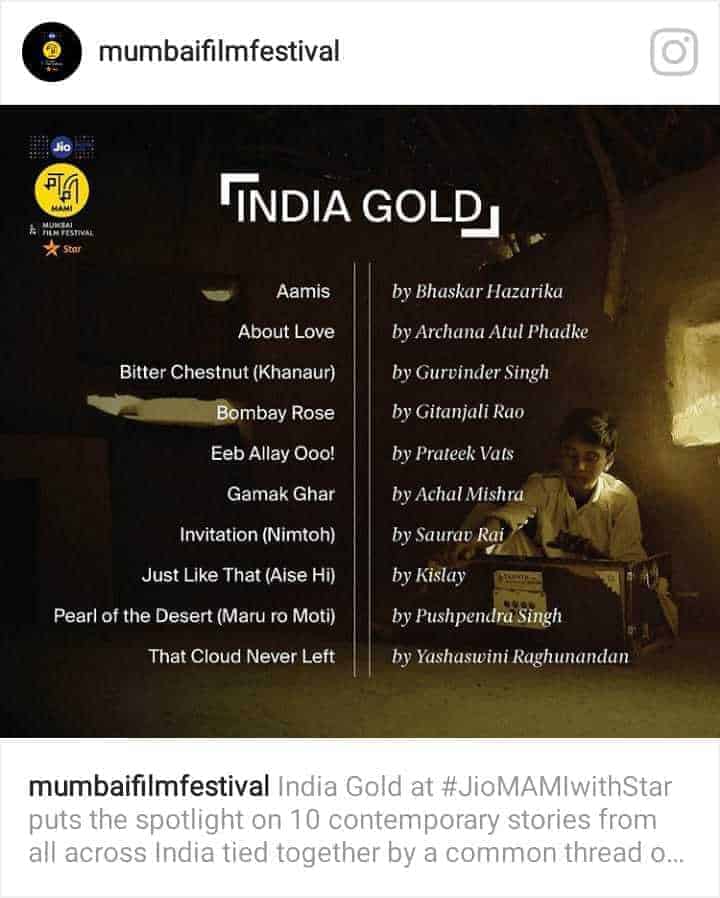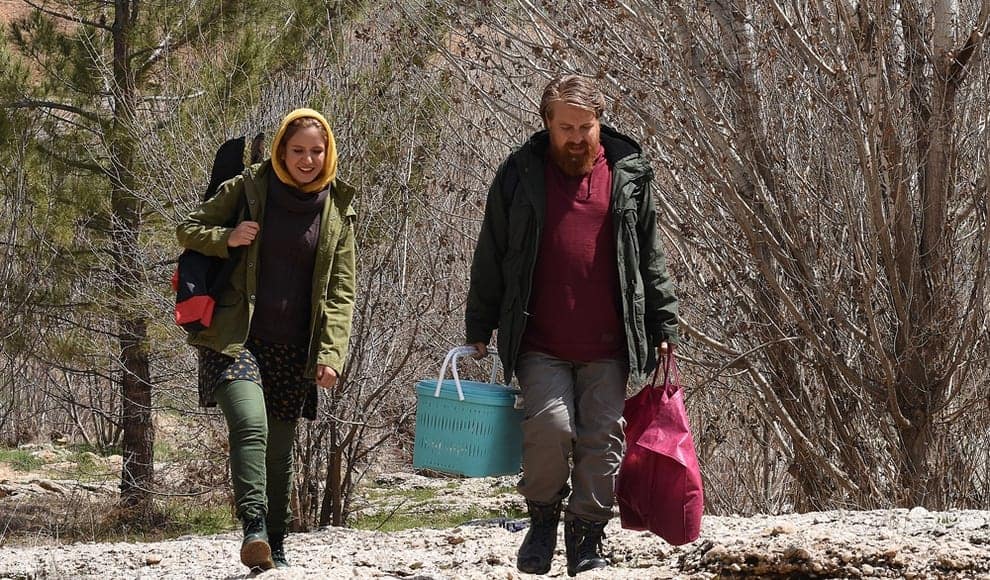by Shounak Majumdar
During my stint in MAMI, I met the curated India Gold section which pulsated in a new lease of energy that came out from the suffocated mainstream. India Gold focuses on the newer trends of Independent cinema across India. It portrays how the line between fiction and non-fiction is gradually blurring. From private financers to co-production market, India Gold curation was the manifestation of the changing ways of production in Indian Independent Cinema. Curated thoughtfully by veteran Deepti DCunha, professor Ratheesh Radhakrishnan and film critic Aswathy Gopalaskrishnan, India Gold presents us a tour of India where industrial power centres are slowly dissolving to the periphery.
Here is a collection of reviews of the ten films that I have seen in India Gold, MAMI.
AAMIS: Meet the ‘meat film’ of the year
Director Bhaskar Hazarika presents us with a very familiar milieu yet with a very unusual story concerning desire. ‘Aamis’ primarily revolves around Guwahati based married doctor Nirmali and young PhD student Sumon. They meet through a doctor’s call and soon Sumon’s affection towards Nirmali grows. But Nirmali’s nuptial knot debars this relationship to proceed. Sumon is a research scholar in Anthropology, his area of research concerns the meat eating habits in North-east India. He makes a special place in Nirmali’s heart with various meat dishes. Nirmali breaks out from her mundane routine with Sumon. Aamis portrays this relationship with extreme care and the background music supports the narrative. Sumon feeds Nirmali his own meat, this he does as an experiment. But soon Nirmali’s hunger for meat takes over her sanity and Sumon keeps on feeding her. Director Bhaskar Hazarika is so competent a storyteller that we can never expect the ending till it hammers us in the end. Editor Shweta Rai Chamling does her job gracefully as we see Nirmali’s alienation with subtle editing. ‘Aamis’ is extremely unique in Indian cinema not just for its dark and uncanny story but also because of how the director is able to narrate it in a deceptively simple tone.
ABOUT LOVE: Studying a Marathi microcosm like never before
‘About love‘ is a chronicler of time focusing on two generation of Phadke’s in a single house. By recording the quotidian space for a considerable amount of time with familiar people and by capturing death, decay and bonding, filmmaker Archana Atul Phadke curates a very intimate story before us. Made in a simple camcorder and inbuilt sound system, this film is truly liberating in its form. It paces almost like a documentary and yet it captures a very telling story and explores patriarchy in a regular space. The inherent study of a Marathi microcosm and specially how the gaze of the filmmaker works here is very unique to Indian film making. The filmmaker has an authority and a gaze at work here, yet when she hands over her camera to her brother, the dynamism and politics change, this elasticity is what the form brings forth here. The film achieves its fullest potential in incorporating the benefits of digital filmmaking. It has explored woman’s lived experience and woman’s writing through Archana’s mother’s scenes,which are nothing short of vivid and proves what taping to hitherto untouched spaces looks like. The use of music is brief and appropriate.
AISE HI: A testament of our times
Director Kislay in his film ‘Aise Hi’ studies a north Indian middle class family of 2019 somewhat with a scientific precision. Sharma family is his sample. His film goes beyond this particular family.
After the old, strict patriarch Mr.Sharma dies, Mrs.Sharma tries to break out from her decade long invisible bondage. This film is about a middle class north Indian family tackling this issue in a rapidly changing Allahabad. Interestingly enough, ‘Aise Hi’ never quiet concentrates on Mrs. Sharma, it loiters around the Sharma household. I don’t remember any single Indian film in recent times that has given such space to each character to bloom its own way.
‘Aise Hi’ examines how easy it is to polarize the contemporary Indian society. It opens up the inner viciousness when we see the young lad from Sharma family beating up an old Muslim tailor just because he is a soothing spot for the lad’s Hindu grandmother. ‘Aise Hi’ speaks about the contractual labour policy that is tearing a million hearts daily in our country. This film propels us to accept the alienation in the characters when it uses old photographs as character arcs. The use of waltz music is also new to the ears. ‘Aise Hi’ is the perfect testament of our times.
BITTER CHESTNUT: Gurvinder is in a colder phase
This story focuses on a community in Bir, Himachal Pradesh. ‘Bitter Chestnut’ wraps the drama around Kishan who is from this community and works in a local cafe owned by an outsider woman with intellectual prowess. Kishan respects her and has a growing distaste for the locality. Director Gurvinder Singh handles the migration issue masterfully. It shows how less jobs in rural side is the reason for uprooting of the local. Kishan has a penchant to go out, yet the experiences that he hears from the outside world debars his wishes.
‘Bitter Chestnut’ is a meditative film and it has a centripetal force that makes the audience immerse into the landscape and yet that is the reason behind not getting the claustrophobia around Kishan that he must be feeling given his nature.
‘Bitter Chestnut’ is the best ethnographic narrative drama to have come out from India in a long time; it observes and goes along with the community. It silently observes the rituals, the celebrations, even the sorrows. The commentary on the community becomes intriguing when we see the documentary film makers filming the community. The mythologizing part with ‘Bitter Chestnut’ is an overdone trope. ‘Bitter Chestnut’ has provided us the gaze to look at a community with dignity and to appreciate the labour, yet it fails to put any coherent dramatic structure.
BOMBAY ROSE: New form, old story. New scent, old rose

Gitanjali Rao presents us a familiar storyline; an immigrant Muslim boy falls for another immigrant Hindu girl in the big city of Bombay. Her animation film ‘Bombay Rose’ mostly works on the ideas associated with the figure. Salim from Kashmir is in search of work, he represents the entire gamut of cultural and political identities associated with a Muslim man struggling to find a place in Bombay. Kamala represents the idea of an exploited woman with unfulfilled desires. By touching several issues like sexual exploitation, immigrant problems, religious violence, child labour, ‘Bombay Rose’ aims to prove a point, yet any significant action or formal device to incorporate that aim is lacking. The warm palette or restrained use of background score yield a good viewing experience. Affection is ingrained in the way the film is choreographed. Salim’s imagination or Kamala’s dream may not resonate with their present condition, but they are thoughtfully crafted and carry a certain influence from Mughal miniature painting. The symbiotic relationship of an average Indian audience with Bollywood is beautifully captured here. Another very rewarding experience of this film is the representation of state, faceless yet brutal. But apart from etching the same black and white story in new canvass, ‘Bombay Rose’ does not do anything new.
EEB ALLAY OOO!: A new realism with cinematic humour and human labour

‘Eeb Allay Ooo!’ traces the life of young migrant Anjani who comes to Delhi to get a job. Ironically enough, his struggle begins as he gets the job. His work is to send away the monkeys who regularly disturb the normalcy of Lutyens, Delhi. The prime location (Lutyens, Delhi) here gets its autonomy early in the film. We, human beings have descended from the monkeys anthropologically yet ‘Eeb Allay Ooo’ presents us how in tough situations our progression can be even backwards. Throughout the film, with clinical cinematography by Saumyananda Sahi and impactful editing by Tanushree Das, director Prateek Vats presents us the story of Anjani who has tapped his inner animal to fight with the wrong world around him. ‘Eeb Allay Ooo’ is a rare film in the way the fictional and non-fictional elements alternate with each other. Actor Shardul Bharadwaj is a treat to watch. His physical acting feeds his vocal mastery and vice versa. The shots where he is performing with Mahinder Nath are etched in brilliance. Director Prateek has found a unique way of balancing darker sides of life with humour. His style of humanizing labour and finding humour in mundane situations make him a very good extension of the Ken Loach style in the Indian context.
GAMAK GHAR: Churning out memorabilia against ravages of time
In this dusty grey time, when originality has lost its way in the dreary desert sand of dead habits, maybe life is worth living only to experience Achal Mishra’s ‘Gamak Ghar’.
‘Gamak Ghar’ is a Maithili feature film that traces τηε journey of a house in rural Bihar in three decades. The first part is about 1998, then comes 2010 and then 2019. Houses are built on bricks, sands and cement yet they are the finest reservoirs of memories. ‘Gamak Ghar’ explores that in a unique narrative.
It starts off with assembling observational shots of a happy family gathering in 1998. The house looks enriched and protected. This sequence is warmly lit and has guitar in the score. Gradually, as the narrative progresses, the palette becomes desaturated and the music becomes more melancholic. It almost goes in parity with the story as the family becomes more fractured through time and the house had also suffered from floods. The visceral impact of passing time on the house is effectively portrayed by the art director.
Shot entirely on Canon C200 ‘Gamak Ghar’ presents us with an array of foggy landscapes which further mystifies the house. Gamak Ghar portrays the Bihari community with a gaze pertaining to ethnic study. ‘Gamak Ghar’ proves what few non actors and few young minds with untapped potential can do for Indian Cinema.
NIMTOH: Imperfect but standing firm on the mountains

‘Nimtoh’ is an observational take on ten -year- old Tashi’s life who lives with his ageing grandmother as tenants of a wealthy family in a remote village in Darjeeling and distract wild animals from their lands. This film is a storage of moments. The scene where the wealthy parents of the groom feel nostalgic upon hearing the wedding song of their son is an example. Moments that are otherwise unheard, unseen in the screen.
The boy of the wealthy family gets married. Tashi works for the function, he delivers wedding cards across the village yet he is not invited. Upon hearing this, the grandmother shows her anger to the tenants and leave their premise. The problem with ‘Nimtoh’ is that all of this action remains much unpronounced and left for the audience to really look for. The gush of the wind, after grandmother and tenant man’s confrontation, accentuates their argument and establishes the location’s primacy over human beings, yet I must say this confrontation looks a bit forceful and unmotivated.
Whenever a filmmaker decides to go and work outside the mainstream, he may face hurdles but it also opens up a lot of possibilities. ‘Nimtoh’ by Sourav Rai is a perfect manifestation of this type of filmmaking. Independent, fierce, imperfect but standing firm on its own.
PEARL OF THE DESERT: Pearl of Indian Cinema
Director Pushpendra Singh takes us to the inner core of Rajasthan eschewing the popular portrayal of Bollywood. His film deals with the Manganiyars, the Muslim singers who have being serving for years in Hindu patronage. Music combines both the communities for centuries. This film is a detailed study of this community, specially focusing their songs and culture during harvest, through the eyes of a boy, Moti with special talent in singing.
Pushpendra’s story has a fragmented approach in its telling. ‘Pearl of the desert’ is essentially about the struggle that Moti Khan goes through to achieve success. Moti practices his craft on the desert. Through Ravi Kiran’s wide lensing and thoughtful compositions, the landscape gets its autonomy. After a point of time we get the feeling that the whole nature is contributing to Moti’s craft.
Pushpendra Singh’s treatment is interesting as this film does not only blur the lines between fiction and non-fiction rather we can say that the non- fictional elements of the story extend to the fictional part. The music design and sound design both have carried the ethnographic essence that the director has in his vision. ‘Pearl of the desert’ draws a lot from Mani Kaul’s ‘A Desert of a thousand lines’ in its style, yet Pushpendra Singh’s originality lies there.
THAT CLOUD NEVER LEFT: A short revenge
“Interpretation is the revenge by intellect upon art.” Susan Sontag
Dark is the moon of lunar eclipse.
Yashaswini’s form is made up of ellipsis.
Kyetketi labourers are shown in detail.
Lots of close ups are in this tale.
Children play in mango trees.
Children search for red rubies.
Children look through glasses red.
Narrative is like a confused thread.
Film strips are striped and trimmed.
Expressive sound designing was in the need.
City people plays with kyetketi and listen to the sound.
Mithun Chakrabarty’s voice and old Hindi songs are also found.
Nothing but tv speaks to the village.
Off screen sound is present like a sage.
While cutting film strips maybe old stories leak.
Yashaswini embodies this formally in a creative peak.
Long gone the seller.
Has he returned from the city?
Lacking emotions.
This film is not for the witty.
Seller’s wife sleeps in disdain.
Realism has newer forms to gain.
What is the line between story and reality?
Look at the dusty grey scape of the city.
Yashaswini’s locations walk on their own.
Villagers watch eclipse from the closest zone.
Behind the good earth, the moon veils in darkness.
For revenge, the Critic brings out the sword in prowess.















